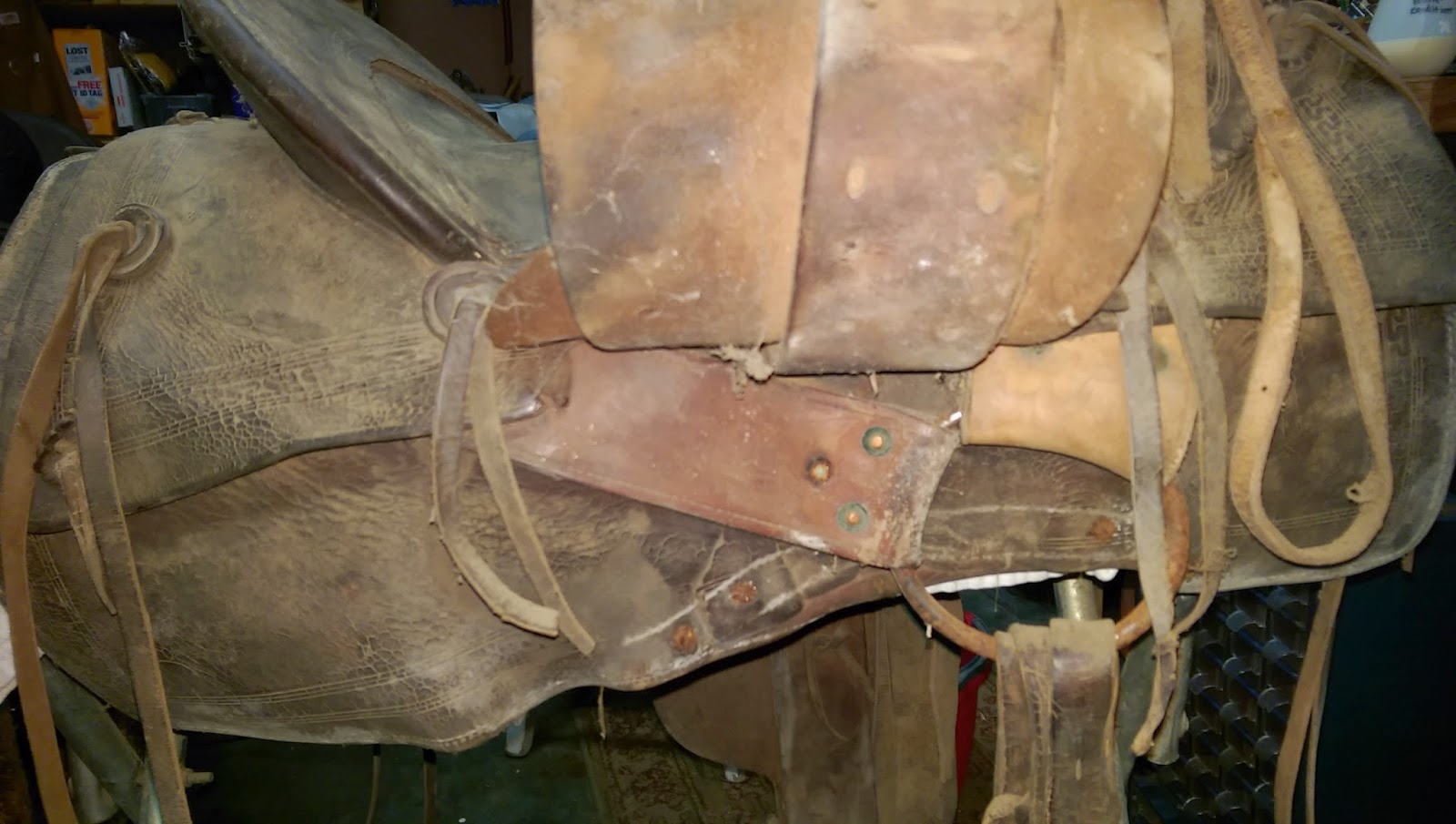Then I opened my books and started reading.
"Loop saddles", named for the open areas in the seat where you can see the stirrup leathers, date from 1880-1920, generously. The visible leathers made it easy for cowboys to check for wear or damage to their leathers, and to replace them. Nowadays it takes a special tool and/or a bit of teardown to replace worn leathers, hidden under the seat of the modern saddle. Why this handy system went out of fashion, I don't know.
I was lucky enough to find a maker's mark barely visible on the skirt that read "Great West Saddlery Co, Maker." GWS was one of the biggest saddlemakers back in it's era. Based in Winnipeg, Manitoba, Canada, with branches in Calgary and Edmonton, GWS made saddles for the Royal Canadian Mounted Police as well as the general public. Based on the appearance and location of the stamp, I can date this saddle to 1905, give or take a year or so. And it's seen a lot in the 110 years since it left the shop, shiny and new.
I've yet to discover what the "80" and the "C" stand for. Perhaps the specific location where it was made? The RCMP sometimes marked their saddles with a unit number, so it may be that. The seller that met me was a young guy, and the only history he could give me was that it had been his grandfather's saddle, so it's entirely possible that Grandpa bought it secondhand and it was once a Mountie rig.
Speaking of rig-- the rigging is 3/4 single ring, and I could explain more fully what that means but it'd be technical and perhaps boring. It's pretty standard to saddles at this time.
Look at that thick dust. Years of grime and sweat and oils -- yuck! The leather was curled up, stiff and dry from years of neglect, and yet...
And yet there were signs that this saddle had been someone's home. There were repairs to the skirt and a second row of stitching showed me that the fleece underneath had been replaced at least once -- although it was completely gone now, except for a few ragged bits caught in the stitching.
See the scar and the rivets there on the skirt? Mustangs are tough little horses and I'm picturing a fella getting bucked out of this saddle and catching his spur on the way off, maybe? What else would catch under the skirt there and rip back? That's pretty heavy leather. At any rate, the owner had a patch stuck on, riveted and stitched. I removed the patch because the rivets had rusted so badly they were eating away the leather. Eventually, I'll place in a new patch with fresh rivets, and stitched along the same line.
It this picture you see another interesting feature-- that concho down in the corner. I hadn't seen that on a saddle before! The other conchos have ties that go through the leather, the wooden tree, and back, holding the saddle together. This extra little guy is just there to tack the corner of that skirt down and keep it from flapping. A touch of fancy, if you will.
A little scrubbing with saddle soap shows promise. It'll never be a showpiece with those scars and cracks, but it will look better. I cut the saddle strings and carefully removed each piece for cleaning.
The greyish-brown gunk in the corner would not wash off. It was like concrete. I'd never seen anything like it. In desperation, I contacted Richard Sherer, a saddle historian and conservator, and asked him if I was wasting my time. I was ready to cut new skirts and tool them to match. I even had the pattern drawn up. His answer reached me just as I was going to start cutting -- don't make new skirts! He said to keep as much original as possible to maintain the historical nature of the piece, and included a recipe for his special soap. I mixed up a batch of the stinky stuff and went back to work. And it was amazing! The dirt was just melting off! I scrubbed and rinsed, scrubbed and rinsed, and finally the skirts were clean.
He didn't answer right away, of course, and as I waited, I got impatient. Finally I took a stiff brush and the soap and just went crazy at a little spot in the corner. I scrubbed that postage stamp-sized spot for about five minutes, all the time worried that I was going to scrub the skin right off the seat, but to my amazement, it finally started getting smaller, and smaller, and finally that little spot was gone! Inch by inch, I scrubbed that seat, never sure that I wasn't going to wreck it at any moment, but lessening that grey blotch little by little until finally it was gone!
I wrote Mr. Sherer again and told him I'd solved the seat problem, and he said it was probably old varnish and sweat that had to be broken through. I never have taken a risk scrubbing leather that hard if the saddle hadn't been such a bargain in the first place. And now look what I'd learned!
I finally had to stop, because it was bedtime. By morning, my clean pieces would be dry and I could start the long process of bringing moisture and flexibility into the leather. Wait til you see!


.jpg)

.jpg)


No comments:
Post a Comment